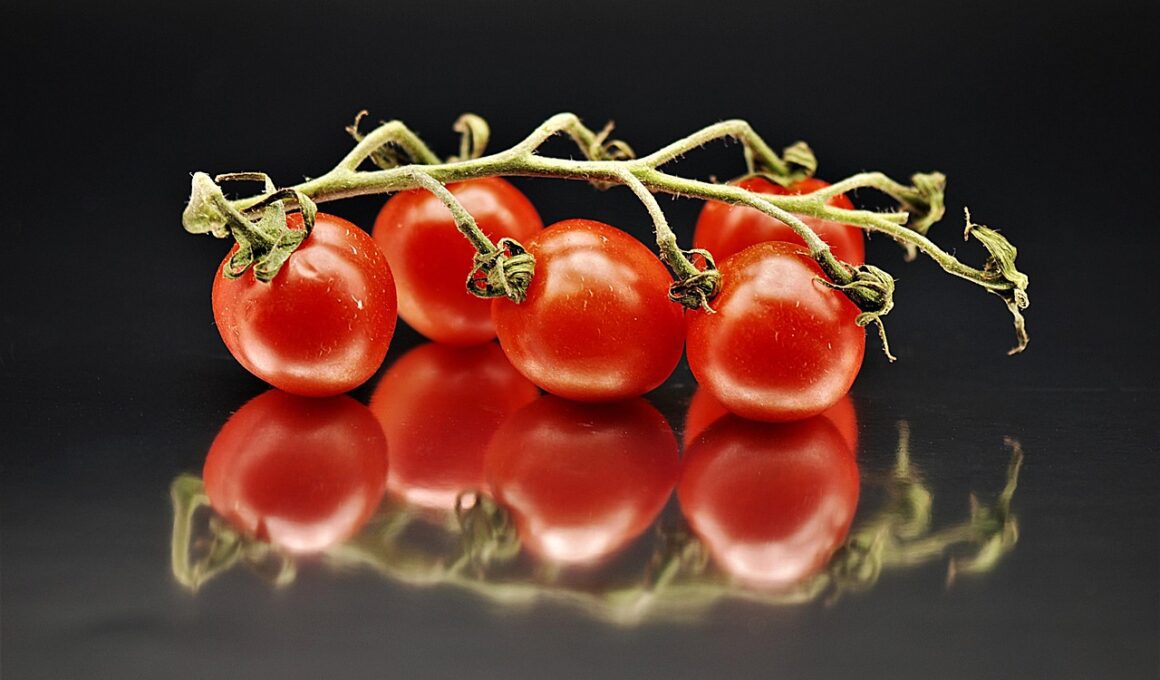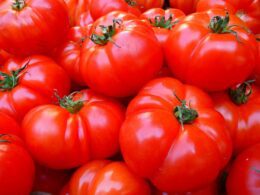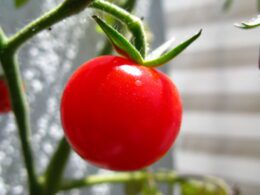You’re gearing up for another bountiful tomato harvest, and you’ve heard that pruning your plants can lead to better growth and yield. But when exactly should you prune those tomatoes?
Knowing the right time to give your plants a trim is essential for their health and safety, ensuring they produce those juicy red fruits we all love. Don’t worry – we’ve got you covered.
In this article, we’ll walk you through the different types of tomato plants, explain why pruning is so important, help you identify the perfect time to prune, share some valuable tips on pruning techniques, and discuss ongoing maintenance to keep your tomatoes thriving.
By following these steps, you’ll have a garden full of healthy tomato plants ready to reward your efforts with delicious produce.
Understanding Tomato Plant Types
Before diving into the pruning process, it’s essential to get familiar with different tomato plant types and their growth habits.
There are two main categories of tomato plants: determinate and indeterminate. Determinate tomatoes, also known as bush tomatoes, have a predetermined growth pattern and stop growing once they’ve reached a certain height. They typically produce fruit over a short period of time, making them ideal for gardeners who want all their tomatoes at once.
On the other hand, indeterminate tomatoes continue to grow throughout the season, providing an ongoing harvest until frost kills the plant. Understanding your tomato plant type will help you make informed decisions on how and when to prune them for optimal growth and yield.
For instance, determinate tomatoes require less pruning than their indeterminate counterparts because they naturally grow in a more compact form. Indeterminate varieties benefit more from regular pruning as it encourages air circulation, reduces disease risk, and allows sunlight to penetrate the canopy of leaves for better fruit development.
When it comes to pruning your tomato plants, timing is crucial. It’s best to start pruning when plants are about 12-18 inches tall or have developed several branches with flowers or small fruits already forming. This stage usually occurs around four to six weeks after transplanting seedlings into your garden bed or container.
Pruning too early may stunt growth while waiting too long can result in reduced yields due to overcrowded foliage competing for light and nutrients. By understanding your plant type and following these guidelines, you’ll be well on your way to enjoying healthy tomato plants with delicious fruits throughout the season!
The Importance of Pruning Tomatoes
Pruning your tomato plants is essential for boosting fruit production and improving plant health. By removing excess foliage, you’ll allow more sunlight to reach the fruits, helping them ripen faster. Proper pruning also helps prevent diseases by encouraging better airflow around the plant.
So, if you want to have a healthy and productive tomato garden, make sure you give your plants the necessary attention and care. By pruning them regularly, you’ll be rewarded with a bountiful harvest of delicious, ripe tomatoes.
Boosting Fruit Production
Ready to maximize your tomato yield? Let’s dive into the art of pruning for a bountiful harvest! Pruning your tomato plants not only helps keep them healthy, but it also encourages more fruit production. By removing excess foliage and focusing the plant’s energy on producing fruit instead of leaves, you’ll enjoy a larger and tastier crop.
To boost fruit production, start by identifying the suckers on your tomato plants – these are the small shoots that sprout from the main stem or between a branch and the main stem. Gently pinch or snip off these suckers when they’re still small, leaving only a few leaves above each cluster of blossoms.
This will allow more sunlight to reach developing fruits while reducing competition for nutrients among branches. With proper pruning techniques, you can ensure both safety and abundance in your garden this growing season.
Improving Plant Health
It’s essential to maintain your tomato plants’ health, and regular pruning plays a crucial role in achieving that goal. By removing unnecessary growth, you’ll help prevent diseases and pests from damaging your plants. Pruning also allows for better air circulation and sunlight penetration, promoting strong and healthy growth.
When you keep your tomato plants happy and healthy, they’re more likely to produce an abundant harvest for you to enjoy. To improve plant health through pruning, start by identifying the suckers – those small shoots sprouting from the joint between the stem and a branch. Remove these suckers when they’re still young, as this will minimize damage to the plant.
Also, be sure to remove any yellowing leaves or unhealthy branches that may harbor disease or attract pests. Remember to sterilize your pruning tools before use to avoid spreading infections between plants.
By taking these steps, you’ll not only enhance the overall health of your tomato plants but also ensure their safety in producing delicious tomatoes free from harmful elements.
Identifying the Right Time to Prune
When it comes to pruning your tomato plants, timing is crucial. Start by focusing on early growth stages, and then transition to paying attention to flowering and fruit development. By understanding these key points, you’ll be able to identify the right time to prune for a healthier harvest.
Early Growth Stages
During the early growth phases, it’s essential to start trimming your tomato plants to promote optimal health and productivity. Pruning at this stage helps create a strong foundation for the plant, ensuring that it can support the weight of its fruit later in the season. It also encourages better air circulation and sunlight penetration, reducing the risk of diseases and pests.
Here are five key points to remember when pruning your tomato plants during their early growth stages:
- Begin pruning when the plant is about 12-18 inches tall or has reached its third set of true leaves.
- Remove any small shoots or suckers that grow in between the main stem and branches.
- Keep an eye out for yellowing or diseased leaves and remove them promptly.
- Be gentle while pruning; use clean, sharp tools to avoid causing damage to the plant.
- Maintain consistent care after pruning, including watering, fertilizing, and staking if necessary. This will help ensure that your tomato plants remain healthy and produce a bountiful harvest.
Flowering and Fruit Development
As your tomato plants burst into vibrant blooms and begin developing juicy fruits, it’s crucial to continue pruning efforts for a flourishing and bountiful harvest.
During the flowering and fruit development stage, focus on removing any suckers that are growing below the first flower cluster. By doing this, you’ll encourage more energy to be directed towards fruit production rather than leafy growth.
Additionally, be sure to eliminate any yellowing leaves or signs of disease to maintain a healthy tomato plant.
Don’t forget to keep an eye on the overall growth of your tomato plants during this stage. Regularly check for overcrowding branches and excessive foliage that could hinder sunlight penetration or air circulation around the fruits.
Gently thinning out these areas will not only help prevent potential disease but also ensure that your tomatoes receive enough light and nutrients for optimal growth and ripening.
With proper pruning techniques in place, you’re well on your way toward enjoying a safe, delicious, and abundant harvest!
Pruning Techniques and Tips
Ready to learn some top-notch pruning techniques and tips for your tomato plants? Let’s dive in!
Pruning tomatoes is essential for promoting healthy growth, increasing fruit production, and preventing diseases. The first thing you need to know is the difference between determinate and indeterminate tomato varieties. Determinate tomatoes grow to a certain size, produce all their fruit at once, and then stop growing. These types require minimal pruning – just remove any diseased or damaged leaves.
Indeterminate tomatoes, on the other hand, continue growing and producing fruit throughout the season. These are the ones that will benefit most from regular pruning.
To start pruning your indeterminate tomato plants, wait until they’re about 12-18 inches tall or have at least six leaves. The main technique you’ll use is called ‘suckering,’ which involves removing new shoots that grow in the crotch between a leaf branch and the main stem. Gently pinch off these suckers with your fingers or use clean gardening shears if they’re too thick to remove by hand. Do this early in the morning when it’s cool outside; this helps reduce stress on your plant while also allowing for quicker healing of any wounds caused by pruning.
Regularly check your tomato plants for signs of disease or damage as well as new suckers that may emerge throughout the growing season. It’s important not only to keep up with sucker removal but also to ensure proper air circulation around your plants by removing lower leaves that touch the ground or any crowded branches competing for sunlight.
By following these simple yet effective pruning tips, you’ll be well on your way towards a healthier, more productive tomato garden – giving both you and your plants peace of mind!
Can Pruning Tomatoes Speed Up Fruiting?
Pruning tomatoes can effectively speed up tomato fruiting by diverting energy to fruit production. By removing suckers and excess foliage, the plant can focus its resources on developing and ripening fruits. This practice can lead to earlier and more abundant harvests, optimizing tomato production for gardeners.
Monitoring and Ongoing Maintenance
In this discussion, we’ll dive into the importance of regular pruning sessions and addressing common tomato plant issues. You’ll learn how to maintain a healthy and productive tomato garden by tackling problems head-on and establishing a consistent pruning routine.
Stay tuned for tips and tricks to keep your tomatoes thriving all season long.
Regular Pruning Sessions
Keep up with regular pruning sessions to ensure your tomato plants stay healthy and thriving! Pruning is essential for maintaining airflow, reducing disease risk, and promoting better fruit production. It’s important to have a routine pruning schedule in place as your plants grow.
Here are four key steps to follow during each pruning session:
- Inspect the plant carefully, looking for any signs of disease or damage.
- Remove any yellowing leaves or unhealthy-looking stems.
- Trim away any small, non-fruiting branches that may be stealing energy from the main fruit-producing areas of the plant.
- Pinch off suckers – those small shoots that sprout between the main stem and branches – to encourage more efficient growth.
Consistently following this pruning process will keep your tomato plants in optimal condition while also ensuring their safety from potential hazards such as pests and diseases. A well-pruned and maintained tomato plant will reward you with an abundant harvest throughout the growing season!
Addressing Common Tomato Plant Issues
Now that your tomato plants are regularly pruned, let’s tackle some common issues that can arise during their growth, ensuring a bountiful harvest for you to enjoy. Addressing these problems promptly will not only keep your plants healthy but also provide you with a sense of safety and assurance in knowing that your garden is well-maintained.
One way to help identify and address common tomato plant issues is by familiarizing yourself with the symptoms associated with each problem. Below is a table outlining three frequent issues, their symptoms, and solutions:
| Issue | Symptoms | Solution |
|---|---|---|
| Blossom End Rot | Brown, sunken spots on fruit’s bottom | Add calcium; ensure even watering |
| Early Blight | Yellowing leaves; brown spots on leaves | Remove affected leaves; use fungicide |
| Tomato Hornworms | Large green caterpillars; leaf damage | Handpick pests; use organic insecticides |
By recognizing these signs early on and taking the appropriate action, you can maintain the health of your tomato plants while easing any concerns about potential threats to your precious crop. With this knowledge in hand, continue nurturing and pruning those tomatoes for a safe and fruitful gardening experience.
Conclusion
In conclusion, pruning your tomatoes is essential for a healthier and more productive harvest. Remember to identify the right time to prune based on the tomato plant type and growth stage.
Keep practicing proper pruning techniques and monitor your plants regularly for ongoing maintenance. With patience and persistence, you’ll enjoy a bountiful crop of delicious tomatoes!









